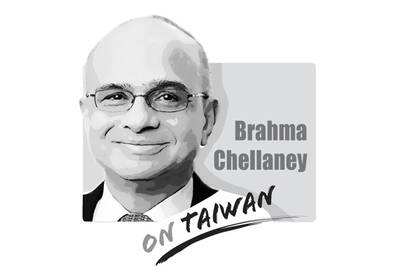Although all eyes were on Tuesday’s meeting between Chinese Nationalist Party (KMT) Chairwoman Hung Hsiu-chu (洪秀柱) and Chinese Communist Party (CCP) General Secretary Xi Jinping (習近平), a few incidents that took place before the meeting boded ill for anyone who expected the KMT to demonstrate values that would show that as a party from democratic Taiwan it was different from the CCP.
Reporters from the Chinese-language Liberty Times (the Taipei Times’ sister newspaper), Taiwanese online media outlet Up Media and the Taiwan office of Hong Kong’s Mirror Weekly were allowed to enter China for the annual KMT-CCP Cross-strait Peace Development Forum. However, on Monday they received calls from China’s Taiwan Affairs Office (TAO) informing them that their press passes for the Hung-Xi meeting had been revoked because of “limited space.”
“Limited space” is not a convincing excuse, especially when all the reporters had registered with the TAO. Even if it was a legitimate reason, why those three outlets were excluded was never specified. The Chinese authorities must believe — as they always do — that they are not obliged to provide credible explanations for the decisions they make, however arbitrary.
While the Chinese government’s arbitrariness and low transparency are a given, the KMT — which for years touted itself as the rightful ruler of a “free China” and now claims to represent the people of a democratized Taiwan — should not view it as a norm.
And yet, from what is known, the KMT has failed to lodge any formal protest with Beijing for restricting Taiwanese reporters’ rights. Worse still, KMT Central Policy Committee executive director Alex Tsai (蔡正元) on Monday brushed the matter aside, saying it “had nothing to do with freedom of press” because “many other media outlets were allowed to report on [the meeting],” so the information was transparent enough for the public.
He said the TAO had “also placed restrictions on the [Chinese] media,” according to the Central News Agency.
Tsai’s response was absurd. He proposed redefining the freedom of the press, gladly buying the Chinese authority’s justification. He surely knew that the Chinese-language Apple Daily’s reporters’ permit requests in China have repeatedly been rejected by Beijing. This time was no exception, as its reporters reportedly traveled to Beijing on tourist visas.
Since when does picking media outlets you favor to print your news fall short of being a freedom of the press violation?
Tsai’s “Chinese media also got blocked” pretext is all the more infuriating and appalling because it is well known that Beijing has been persecuting Chinese reporters and imposing censorship on the nation’s press and publishing industry. Is the fact that Chinese journalists have constantly suffered from government intervention really a good justification, in Tsai’s eyes, for an arbitrary dismissal that should be universally condemned?
It also turned out that the start of the Hung-Xi meeting was changed from 3pm to 4pm, reportedly because the CCP was not happy that the KMT on Monday unilaterally announced the meeting time.
The KMT also probably did not object when a person waving a Republic of China flag in Nanjing was escorted away by the police.
Trivial as these incidents might seem, they show that the KMT is completely under the sway of Beijing, which is sad to witness for those who remember how it once fervently trumpeted an anti-CCP mantra, believing it could replace the CCP one day.
Taiwan-India relations appear to have been put on the back burner this year, including on Taiwan’s side. Geopolitical pressures have compelled both countries to recalibrate their priorities, even as their core security challenges remain unchanged. However, what is striking is the visible decline in the attention India once received from Taiwan. The absence of the annual Diwali celebrations for the Indian community and the lack of a commemoration marking the 30-year anniversary of the representative offices, the India Taipei Association and the Taipei Economic and Cultural Center, speak volumes and raise serious questions about whether Taiwan still has a coherent India
Recent media reports have again warned that traditional Chinese medicine pharmacies are disappearing and might vanish altogether within the next 15 years. Yet viewed through the broader lens of social and economic change, the rise and fall — or transformation — of industries is rarely the result of a single factor, nor is it inherently negative. Taiwan itself offers a clear parallel. Once renowned globally for manufacturing, it is now best known for its high-tech industries. Along the way, some businesses successfully transformed, while others disappeared. These shifts, painful as they might be for those directly affected, have not necessarily harmed society

China badly misread Japan. It sought to intimidate Tokyo into silence on Taiwan. Instead, it has achieved the opposite by hardening Japanese resolve. By trying to bludgeon a major power like Japan into accepting its “red lines” — above all on Taiwan — China laid bare the raw coercive logic of compellence now driving its foreign policy toward Asian states. From the Taiwan Strait and the East and South China Seas to the Himalayan frontier, Beijing has increasingly relied on economic warfare, diplomatic intimidation and military pressure to bend neighbors to its will. Confident in its growing power, China appeared to believe
Legislators of the opposition parties, consisting of the Chinese Nationalist Party (KMT) and the Taiwan People’s Party (TPP), on Friday moved to initiate impeachment proceedings against President William Lai (賴清德). They accused Lai of undermining the nation’s constitutional order and democracy. For anyone who has been paying attention to the actions of the KMT and the TPP in the legislature since they gained a combined majority in February last year, pushing through constitutionally dubious legislation, defunding the Control Yuan and ensuring that the Constitutional Court is unable to operate properly, such an accusation borders the absurd. That they are basing this